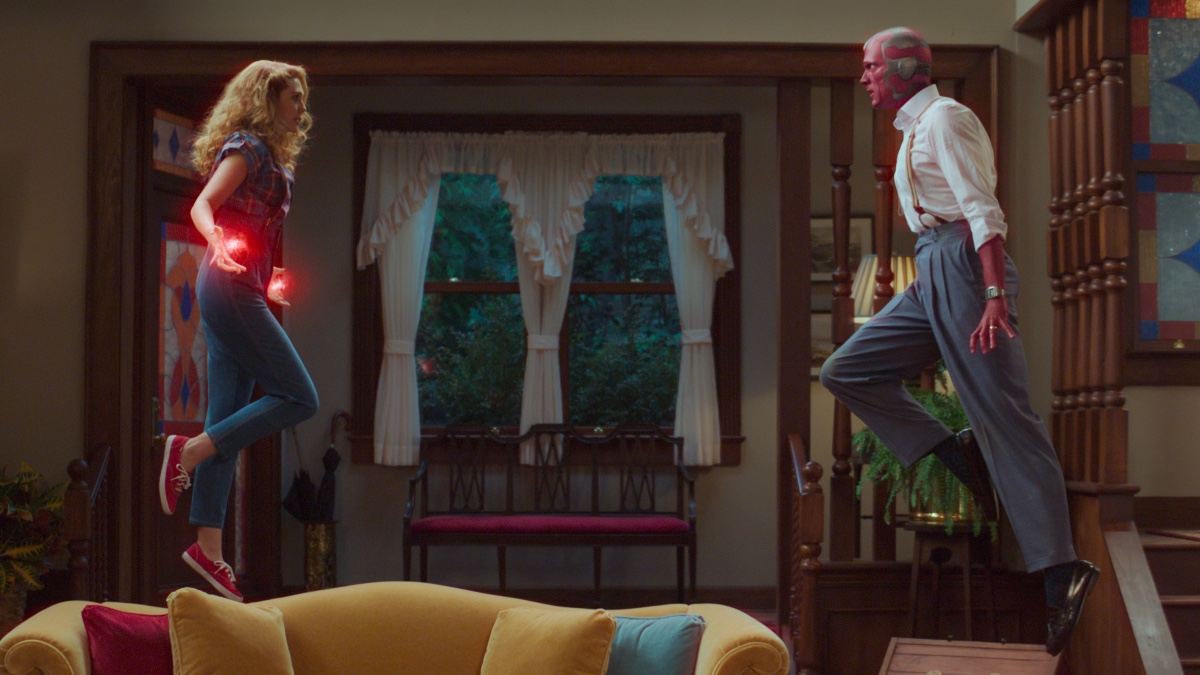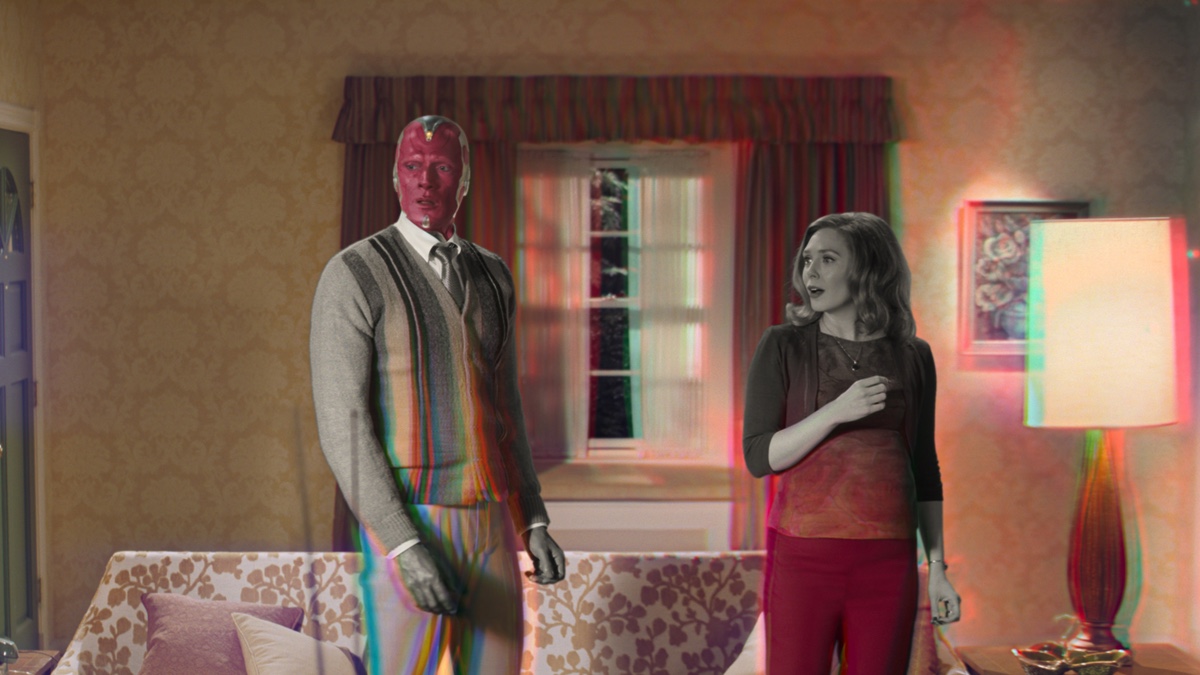
It might be hard to determine exactly how big a hit Marvel Studios’ first Disney+ series, WandaVision, is, it seems like the only thing anyone was talking about for the last two months, maybe because it was the first anything from Marvel Studios anyone had seen since July 2019.
The series stars Elizabeth Olsen and Paul Bettany, reprising their Wanda and Vision characters from the Avengers movies, but putting them in very different situations, from recreating classic television shows like I Love Lucy and more current ones like American Family, but also providing all the action and adventure we’ve come to expect from all the MCU movies.
The show required a lot of visual effects, and definitely more than other recent Marvel shows like Daredevil and Agents of S.H.I.E.L.D., mainly because one of its two main characters, The Vision, is almost a completely CG character that’s based mainly on Bettany’s performance on set. There’s also the magical reality created by Wanda known as The Hex, in which the small town of Westview, New Jersey, is transformed into different eras, some even in black and white to match the concept of being a ‘50s or ‘60s sitcom.
Leading the vast VFX team needed to make WandaVision a reality was Marvel Studios’ newest VFX Supervisor, Tara DeMarco. Below the Line spoke with Ms. DeMarco via Zoom last week, and in case it isn’t obvious, there may be a few minor spoilers about WandaVision in this conversation.
BTL: Before we talk about WandaVision, I’d love to know more about your background before getting into VFX?
Tara Demarco: I went to college for fine art photography, a kind of wacky major called Studio for Interrelated Media at Mass Art in Boston, and then ended up paying for college by having a .com job, which led me to animation, which then led me to editing and After Effects. And that led me to Flame. For a long time, I was a Flame artist and supervisor and would do smaller projects, but eventually, you know, got drawn in by the MCU.
BTL: Sorry, is Flame a VFX House?
Demarco: No, Flame is a software/hardware combination. It’s a compositing tool. Similar to Nuke. It was one of the early compositing tools that would use a big mainframe style computer, and it was just a slightly more real time version of working. So I came from compositing.
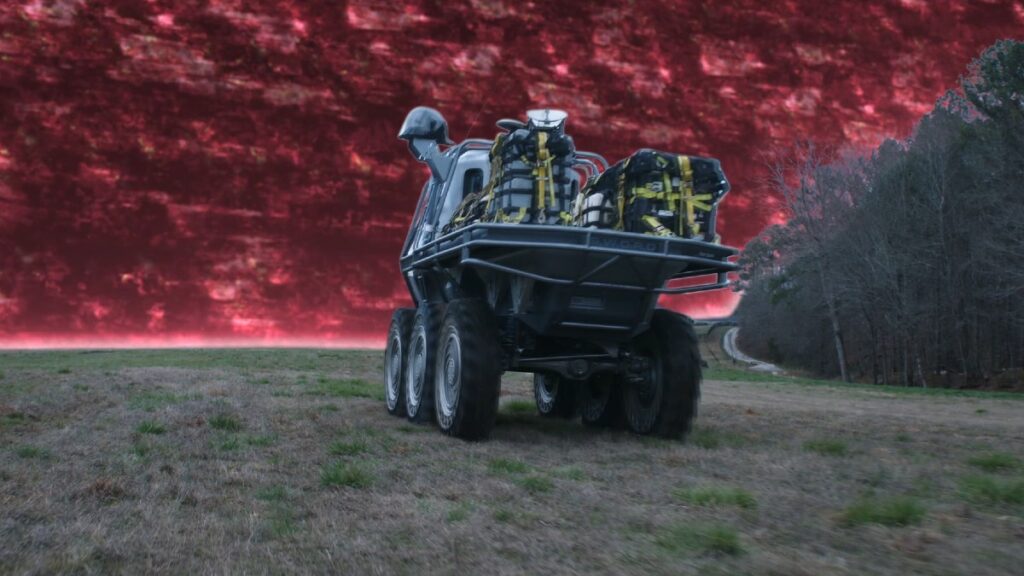
BTL: Do you work out of a VFX house, or are you a person at Marvel?
Demarco: I am a person at Marvel now.
BTL: Everyone talks about the look of the Marvel movies, and you expect that means they’re always working with the same people, so when you see a new name, you wonder where did that person come from pre-Marvel?
Demarco: Yeah, the place I came from was called The Mill. They worked on Gladiator back in the day, and we did lots and lots of Super Bowl commercials, and big high-end commercials. When streaming started, I met with Daniel Acosta, and we just talked about what the shows might need in terms of nimbleness in order to achieve the scope of work and the time, because no, we hadn’t done it yet. No one at Marvel really knew what it was. It was like, “We have a recipe for our features. We’d like to apply that recipe, but we may need to change it up.” So really, we all talked, and they discovered that I had a skill set that they were interested in. And it’s worked really well actually.
BTL: When you hear about Marvel doing a TV show, you think about Agents of S.H.I.E.L.D. or the Netflix shows, but never think of something on a scale or level of VFX of the movies, since it would take a long time to complete a VFX-heavy TV show. Had you done any television stuff before this?
Demarco: I’ve actually never done TV before. We worked on a couple of films for Brian Buckley, we worked on a film called The Bronze that opened Sundance. At the facility, we worked on a Showtime show for Michelle Gondry. I had done some long-form work and some music videos, which end up being kind of artsy and long, but nothing like this. But, you know, it is the same tools, just applied to a much longer picture. In terms of translating the Marvel style of scope to television, it was a conversation that was had from Day One with everyone, with production and the director about where to use that scope. We knew that we had a lot of content and a lot of sitcom and a lot of set built, but then we tactically chose scenes… we chose specific scenes to grow the scope, so we would know that after being in the sitcom for so long, in Wanda’s small house, you could get to the pop-up base, and it would feel vast, or we can do a big sweeping shot, and all of a sudden, that would give you the Marvel scope, we’re used to seeing.
BTL: I only realized 10 or 15 minutes before this interview that Marvel had done this Assembled behind the scenes show which might have answered a few of my questions but I did pop in to see if I could get any info from those quick bites.
Demarco: What Assembled was about is preserving the story. It’s really all of the actors and all of production talking about serving the story, and that is ultimately the job of visual effects is to determine whether or not the things that we’re bringing to the table tell the tale of Wanda and Vision. That was our North Star, so as long as we kept going to it, we were fine.
BTL: Obviously, if you work in Marvel, I assume you had scripts for all seven episodes in advance before they even started shooting? You must have known that at a certain point in the show, you’d have much more FX-heavy sequences.
Demarco: We had scripts for most of the episodes before we started filming. We ended up doing some revisions and some rewrites, and the final episode was written sort of as we were already into filming. I think it landed just before we started, but then we prepped it as we were going.
BTL: Were there any scenes that jumped out that you knew would offer specific challenges?
Demarco: For sure. Episode 8, which is like a continuous action and that we follow Wanda from scene to scene. There are such big emotional beats in there, with Wanda creating the house and Vision and with Wanda seeing vision on the operating table. We had that script well before we shot, and we planned those scenes for a long time, knowing that they were emotional and complicated, so they would require some extra time to get them right.
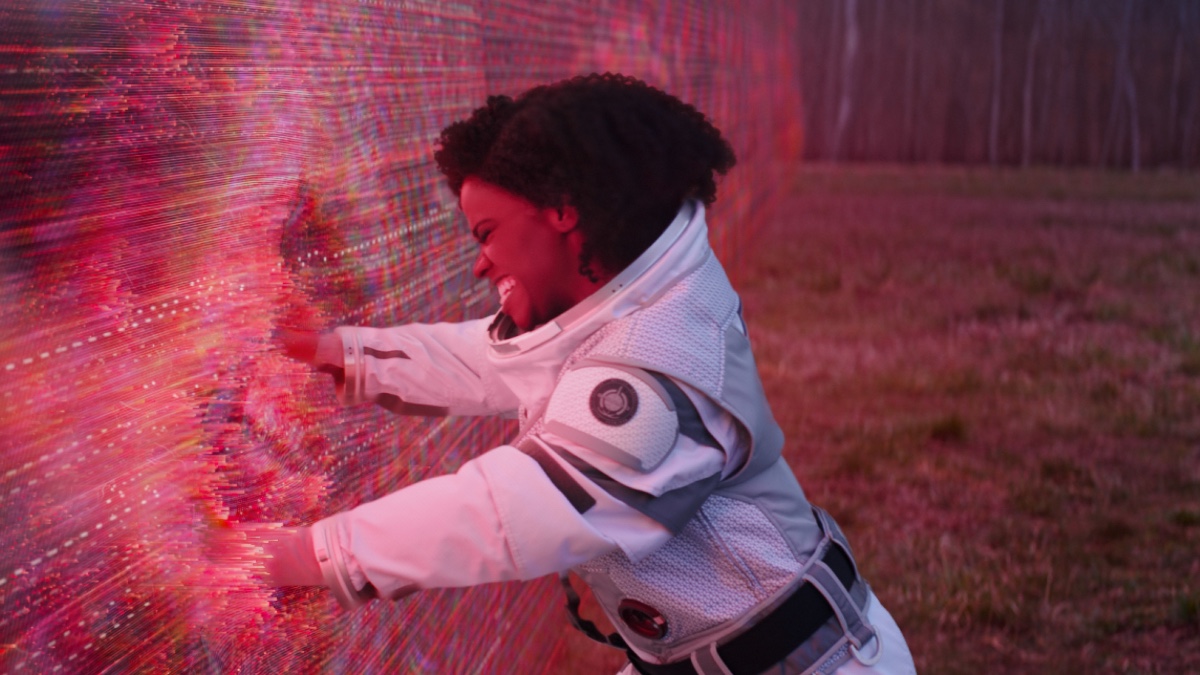
BTL: Are you on set while they’re filming, and do you have a team of animators there working on stuff while they’re shooting or is most of the VFX happening after the fact?
Demarco: We did pre-vis while we were shooting. As we would break down each script with Matt [Shakman, series director] and the rest of the production crew, we’d discuss what we might like vis for, either to help us determine how to shoot it, or to know what the look might be later, so that we could plan for that and know what the right cameras and lenses might be. So we did continue to work on pre-vis well into filming, to iterate and improve and get the scenes closer and closer up until the shoot day.
BTL: If you did pre-vis, did you end up doing any virtual production? That’s something that’s being talked about a lot. It’s fairly new, but it does require a lot more pre-production.
Demarco: We did not. And we had so much practical production, we built those sets for every interior house. A lot of virtual production is to help you know with the time or the scale of a particular set, and we had a lot of great sets for real.
BTL: I was kind of surprised, because in the documentary, I did see, I think it was the Production Designer, talking about the Town Square being a real set and a lot was real set, which was unexpected. A big deal obviously is transitioning between the town in the Hex and in the real world. Was there a town square in black and white and one in color, and it was a matter of switching between them or was there a lot more involved, like changing signage using CG, etc?
Demarco: What it ended up being was that everything that is modern and MCU, like everything that is truly modern, had a 2:39 aspect ratio and a specific set of lenses. And then everything that was from an earlier episode 101 or 2 or 3, even up through the other sitcoms, they had their own sets of lenses. When we were preparing to film, the sets changed some — they would change a little bit for era in their set decoration. But the building stayed the same. What changed with the lensing and then the coloring in DI, in our own finishing process. So we would know ahead of time, this scene is meant to be INSIDE the sitcom world – it should be black and white and square. So let’s use the first period set of lenses and make sure that we have that really romantic fall-off that we got on our 4:3 lenses.
BTL: Some of that was done in production with the cinematographer, then?
Demarco: For sure. We tested together, Cinematographer Jess Hall and I, worked on tests with the DI team at the beginning in prep, just to make sure that we liked the look of our finishing all the way through, so that we could commit to those period lenses, and then know later, we would need to finish with a particular look. And the lenses contributed to that look.
BTL: Would a show like this be possible if you went the normal route of having multiple directors? Was the fact you had one director on all episodes kind of crucial to make it all work?
Demarco: I think with exceptional amounts of planning, it might be possible with multiple directors, but it was definitely a boon to that to have one director.
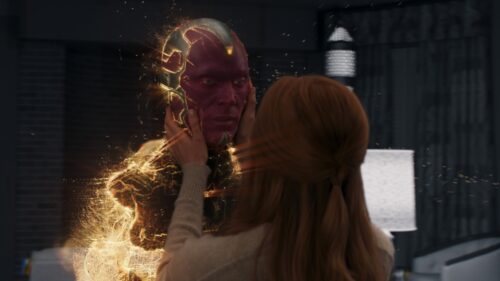
BTL: You worked with a bunch of different VFX houses also, so how did you dole out the work? Was there a specific house that was good for Vision or for those action sequences and the stuff in the Hex?
Demarco: Absolutely. We looked at the vendors ahead of time and did a bit of casting where we looked at what their strengths were and then what the teams were interested in working on. We would have calls with a few vendors for each chunk of work that we would bid out and meet with their supervisors and get a feel for if that was work that they were keen to do or they felt they might be good at. And then we would try to play to their strengths. We ended up with quite a few vendors doing Vision. It used to just be one, and we had way too many shots for that, and that meant a few people had to test and get the look and make sure we could do it. And then we went for sort of known quantities for the other work whenever possible.
BTL: I’m a big comic book fan, and I’ve always been a fan of the Scarlet Witch and the Vision back from reading The Avengers comics, and this show, especially towards the end, they were finally given the spotlight liked, because you can only do so much with them in a movie when you have ten Avengers.
Demarco: No, it’s true, and it would be surprising how often we’d pull out the comics, and be, “Like this. It should look like this image from this comic. This is our reference. Let’s start here and then figure out how to make it photoreal. But yeah, we used the comics a lot.
BTL: How was it working with Paul Bettany for the Vision? Obviously, there’s some digital doubling in places, since it would be impossible to do some of that stuff. Did they shoot some stuff on green screen stages at any point as well?
Demarco: Absolutely. We flew them all over the place. They were incredibly gracious, and were willing to do just about anything we needed to get the shots. Generally speaking, we would have a hero action with the real person and do a digi-double takeover for a camera movement that we maybe couldn’t get, or a physical move that we couldn’t get. If we were limited to how the wires worked, where the camera could go. So anytime they’re touching the ground or embracing one another, like all of that was for real, and we did a ton of flying. And then there were a handful of scenes that ended up being full Digi just because it was too much. There’s no way we could have whipped them around that much. They wouldn’t have liked it.
BTL: There’s certain things like The Vision passing through objects, so is that easier to do now having figured it out, or are you always having to work things out beforehand how you’re going to do them?
Demarco: You always have to work it out beforehand, because all of those scenes are about what’s in front of him, what he’s passing through, and what’s behind him. So every scene where a character goes invisible, you really need to think about what they’re passing through and how to get in camera, the objects without the item they’re passing through and then with, so that you can get that action and the transparency and have reference for what the path of travel is. I mean, it’s often based on the in-camera photography, and then enhanced.
BTL: How does it work on set when you’re there? Does Matt come to you and say, “We need to do this…” Are there a lot of those kinds of conversations back and forth? Is it what he needs and wants to shoot vs. what you can get from the actors?
Demarco: We all talked a lot ahead of the day of the shoot and plan all of those passes that we like for good reference take time. So if humanly possible, we would dig in, and try to give Matt an idea of what pieces we might need, and he might decide, “Great, I’m gonna do one shot with Paul. Can you and a second unit come back later and get the rest?” Or “You know what? That’d be great. We have a hair and makeup change, so yeah just stay, and do all the passes you need,” or “You know what? We need to do this in a few different locations, so we’ll just have Paul sit for a minute, get all your passes, have him stand back in…” It was really per day. Matt did know and was incredibly respectful and helpful and caring, making sure that we got all the pieces to get the best-looking image.
BTL: People really loved how you recreated the old ‘50s and ‘60s television shows, and though you can do so much with VFX these days, but was there something about trying to do things more practically as much like what they would have done with wires and then you remove the wires in VFX?
Demarco: Absolutely, for sure. We love puppeteered wirework for the ‘50s and ‘60s effects, and we did that as much as we could, as much as time would allow and was practical within the sets we built and within rigging equipment. I mean, the plate smashes, just where it comes back together, is just reversed footage. There were quite a few of those, where we went for what they would have done in the era, and I think it worked great.
BTL: Definitely. How did COVID affect everything? Obviously, it affected everyone last year. Had you already finished shooting everything before the shutdown or did you have to come back and shoot more?
Demarco: We had not finished shooting. We had wrapped Atlanta naturally and were coming back to LA to do our backlot filming, which was featured in the final episode and a few others, really all the exteriors. And then COVID. So that meant that production stopped. A few people stayed on to help plan for contingencies, and we stayed on just working on shot work that had been completed. We didn’t have any complete episodes when we stopped, because everything did rely on some exterior that would be found in Los Angeles.
So then we prepped in the late summer and started filming at the end of summer for a good long while to get all the rest of the work we owed, which ended up encompassing the rest of principal photography, a few little pieces of additional photography, and then COVID protocol. We would set people slightly further apart than originally planned. We did a few things as plates, or maybe a cutaway rather than put someone in too much of a crowd. We were COVID- mindful and lucky enough, even though the weather was crazy bananas, we were outside, so that took one COVID fear not away, but it definitely made it for everybody to feel more comfortable coming back to work, knowing that we’d be outside for a lot of the work. So it wasn’t the unknown quantity of indoor space, and how much ventilation. It sounds like now all productions have worked out that they’re sound stages and they’re sound safe, but at the time, since we were an early show to come back, we were happy to be outside.
BTL: I don’t know if you have an office at Marvel. I assume you do, but I’m not sure if you have monitors to all the different places doing VFX for the show, and there’s always the time zone differences, which is a fun thing.
Demarco: We were lucky enough that we all on the show were finishing based in LA, and I live not too far from the Disney studio. I mostly worked from home. We did a lot of our early color grading sessions from home before we figured out what the indoor safety requirements would be. And then later in the process, we were able to go into an office occasionally. So there is a screening room with a beautiful television. There’s a DI suite with some really spectacular monitors, and we were able to do sessions. Disney actually set up little separate rooms for the director, the DP and I, that we could all be on the same phone call at the same time that the colorist was working but see the high-re image on the lot in our own little rooms and be COVID-safe.
BTL: Since you’re working at Marvel, you can’t say much, but do you have another project you’re working on next. We know there are movies and other shows coming up, but have you started working on anything?
Demarco: That remains to be seen.
BTL: Do you think you’ll generally stay on the television side of things or just be available for whatever is needed?
Demarco: You know, whatever’s needed. The groups are phenomenal. I love both sides of Marvel — it’s kind of one big family.
BTL: So far, these TV shows are pretty impressive. Obviously, some things were delayed, but now Marvel has this huge pocket of things coming out this year, versus last year, where there was nothing, which was crazy.
Demarco: Oh, absolutely, and as a fan, I’m super excited to see the next two shows. Like we all were filming at the same time, but we never get to see what each other are making. I have no idea what they’re about. I am super-stoked!
BTL: Now that theaters in L.A. have reopened, do you think you’ll have a Marvel family screening of stuff or will you still have to wait?
Demarco: We had a few very sweet friends and families Zooms. We did a premiere, and we did a final episode Zoom where Matt and some studio peeps, and the editors, we all got on and said “hello” and everybody hit play at the same time. That felt nice.
The entire first season of WandaVision is available to watch via streaming on Disney+. Look for our interview with Ryan Freer from Toronto VFX house, MARZ, also talking about WandaVision, later this week.
All images courtesy Marvel Studios and Disney+.

